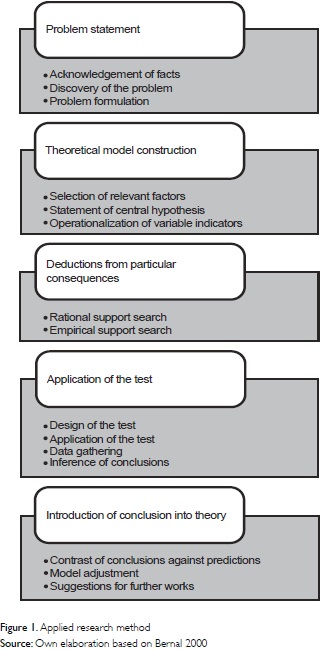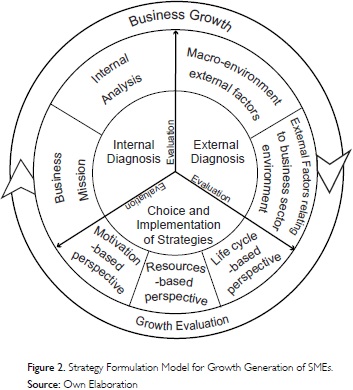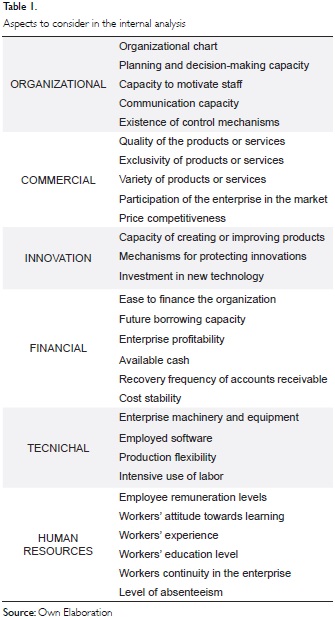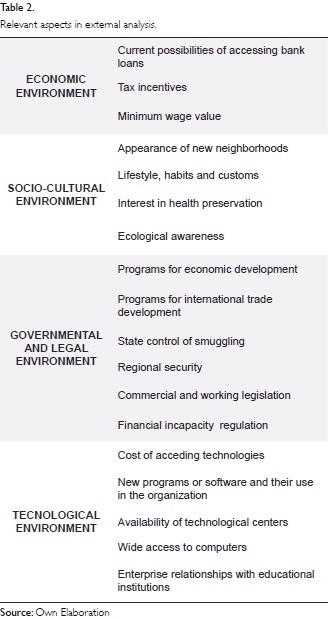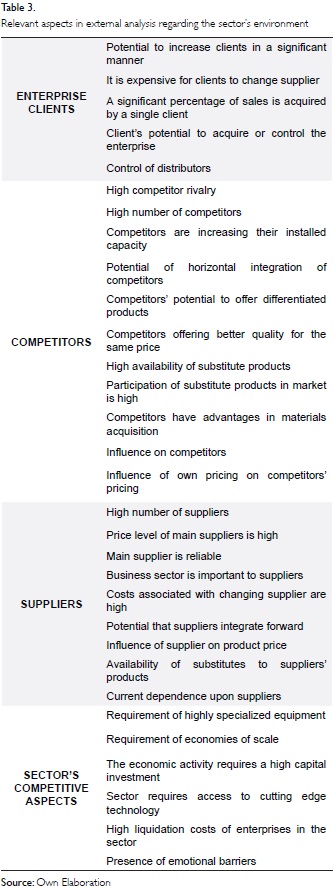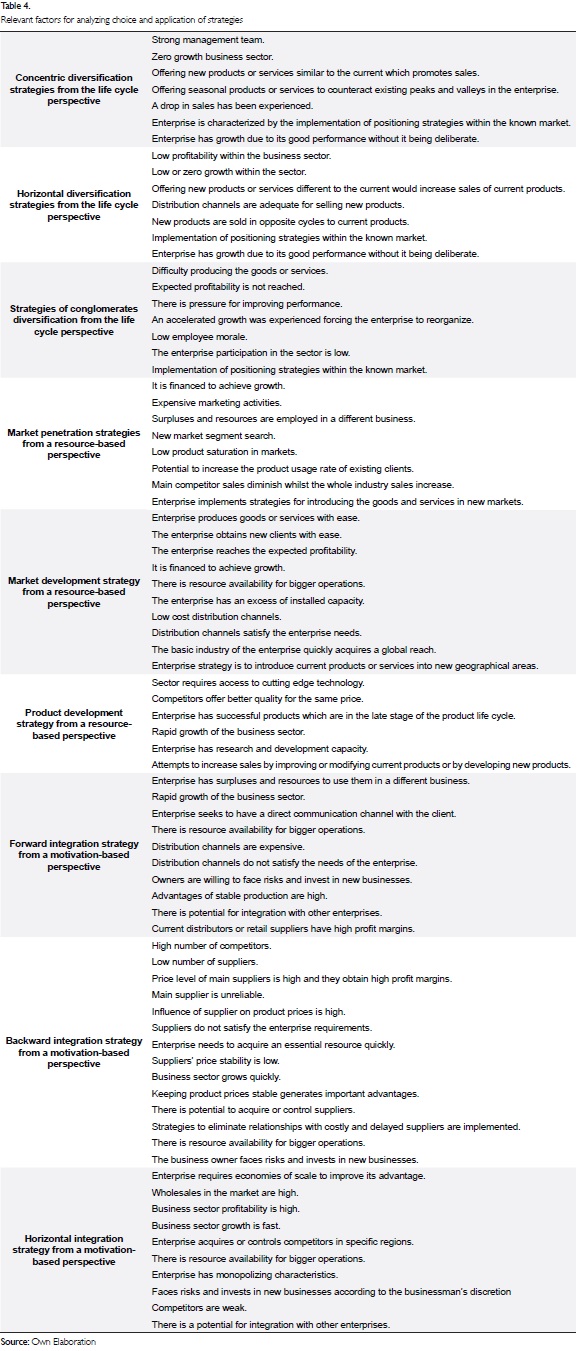Services on Demand
Journal
Article
Indicators
-
 Cited by SciELO
Cited by SciELO -
 Access statistics
Access statistics
Related links
-
 Cited by Google
Cited by Google -
 Similars in
SciELO
Similars in
SciELO -
 Similars in Google
Similars in Google
Share
Entramado
Print version ISSN 1900-3803
Entramado vol.12 no.2 Cali July/Dec. 2016
https://doi.org/10.18041/entramado.2016v12n2.24204
http://dx.doi.org/10.18041/entramado.2016v12n2.24204
Model for developing strategies specific to sme business growth*
Modelo para la formulación de estrategias orientado al crecimiento empresarial de las pymes
Modelo para a elaboração de estratégias PME orientadas crescimento do negócio
Adriana Aguilera-Castro**, Viviana Virgen-Ortiz***
* This article is the result of the Research Project: Application of a model for strategies formulation for generating Business Growth Policies in SMEs in Santiago de Cali - Colombia, financed by Universidad del Valle - Colombia, through internal contest. The project was developed within the Line of Research in Organization and Management of the Humanism and Management Research Group.
The model application in SMEs of Santiago de Cali, was published in the journal Entramado Vol. 9 No. 2, 2013 (Julio - Diciembre). pp. 82 - 97.
** Master in Organization Sciences. Associate Professor at Universidad del Valle, Cali - Colombia. Department of Administration and Organizations, Humanism and Management Research Group****. adriana.aguilera@correounivalle.edu.co.
*** Master in Organization Sciences. Assistant Professor at Universidad del Valle. Cali - Colombia. Faculty of Administration Sciences, Department of Administration and Organizations. Economic Value Generation Research Group. viviana.virgen@correounivalle.edu.co.
**** Author for correspondence - Street 4B Nr 36 - 00 Building 124 Office 3001, Santiago de Cali - Colombia. Phone: 5185736.
Este es un artículo Open Access bajo la licencia BY-NC-SA (http://creativecommons.org/licenses/by-nc-sa/4.0/)
Cómo citar este artículo: AGUILERA-CASTRO, Adriana; VIRGEN-ORTIZ, Viviana. Model for developing strategies specific to sme business growth. En: Entramado. Julio - Diciembre, 2016 vol. 12, no. 2, p. 30-40, http://dx.doi.org/10.18041/entramado.2016v12n2.24204.
Recibido: 05/11/2015 Aceptado: 15/04/2016
Abstract
This paper will propose a model for formulating strategies that is aimed at business growth for small and medium sized enterprises (SMEs), and considers two complementary theoretical approaches: strategic planning and business growth.This article will provide SMEs with a me-thodological tool that enables them to adapt to external and internal factors that impacts them when formulating their growth strategies.
Keywords: Model, strategies formulation, business growth, SMEs.
JEL classification MIO, L21, L25
Resumen
El presente artículo propone un modelo para la formulación de estrategias orientadas al crecimiento empresarial de las pymes, que considera dos corrientes teóricas que se complementan: la planeación estratégica y el crecimiento empresarial. El objetivo de este artículo es presentar a las Pymes una herramienta metodológica que les permita adecuarse a los factores externos e internos que impactan a la organización al momento de formular sus estrategias de crecimiento.
Palabras clave: Modelo, formulación de estrategias, crecimiento empresarial, Pymes.
Códigos JEL MIO, L21, L25
Resumo
Este artigo propõe um modelo para o desenvolvimento de estratégias de crescimento das PME orientadas para o negócio, que considera duas correntes teóricas que são complementares: planejamento estratégico e crescimento do negócio. O objetivo deste artigo é introduzir as PME um instrumento metodológico que lhes permite adaptar-se a factores externos e internos que impactam a organização na formulação de suas estratégias de crescimento.
Palavras-chave: Modelo, formulação da estratégia, crescimento do negócio, PME.
Classificações JEL MI0, L21, L25
Introduction
Strategic planning promotes forward-thinking, reduces the attention to operative details, and provides meaning for identifying and evaluating strategic alternatives that improve the performance of organizations (Lopez, 2005, p. 158).
The process of strategic planning is as important for big companies as it is for small and medium size companies, sin-ce it enables them to establish, in a comprehensive way, the necessary actions to achieve their goals. According to David (2003 p. 185), since the historical creation of organizations, the strategic direction process, even if performed in an informal way or carried out by the businessman or the owner, significantly improves the growth and prosperity of firms.
One of the main tasks of chief executive officers (CEOs) is to achieve an adequate articulation between the goals of organizations, the organization's internal characteristics and its external environment in which it operates. This is achieved by implementing strategies that allow them to stay in the market and grow.
For the strategy formulation, David (1997) considers four main topics: the business mission, the external evaluation, the internal evaluation, and the analysis and choice of the strategy. David (2003) indicates that the strategy formulation is based upon the evaluation of the way an enterprise operates and the identification of the mechanisms that allow it to be more efficient in its tasks, the reason for which strategies must evolve before they become obsolete.
Within the theory relating to strategic direction, there are many different tools and concepts for strategy formulation which contribute to significant improvements in the quality of strategic decisions organizations make, and by integrating with a practical scheme, they can identify alternative poten-tial strategies. The above demonstrates that strategy formulation is a systematic action which allows organizations to project into the future (Aguilera, 2010; Blank, 2002; David, 2003; Frances, 2006; Hax and Majluf, 1996; Wheelen and Hunger, 2007). Therefore, strategies should arise from the identification of current strategic directions of companies, which enables them to grow and consolidate; preserve and maintain; or harvest and alienate; particularly, considering that a company without a sense of direction or a coherent strategy, is directed towards its own demise. (David, 2003).
1. Theoretical Aspects
The general environment of organizations is very dynamic and can cause periods of imbalance; this is particularly important for SMEs, because a drastic change in their environment can be responsible for their disappearance.
In the current environment, it is necessary to develop a model for strategy formulation oriented at business growth focused on SMEs. The model proposed integrates two thematic, which for their conceptual and methodological development constitute significant support for strengthening the elements that sustain the competitive scheme of organizations by enabling them to face that dynamic environment accurately, and effectively position them in the market; these thematic are Business Growth and Strategic Planning.
1.1. Business Growth
In the Harvard Business Review (1999, p. 57-58) it is ex-pressed that the foundation of a company's growth is built upon the way in which their executives focus the strategies. Chiavenato (2006, p. 15) notes that: growth is an unavoidable consequence of organizational success. For Álvarez (2001, p. 104) knowing the strengths and weaknesses of an organization allows wise decision-making derived from the company's growth. Hodge, Anthony and Gales (1998, p. 174), point out that growth can be achieved through strategies oriented to increasing production and sales, entering new markets, mergers, acquisitions and other binding strategies. According to Correa (1997, p. 88) for business growth to exist, organizations should strive for an internal competitiveness directly related to efficiency and organizational structure and an external competitiveness oriented to the organization's elaboration of achievements within the market's context, or the field to which they belong. Blázquez, Dorta y Verona (2006b) claim that business growth is conditioned by both internal and external factors, which may explain the adoption of growth as the intended strategy by the direction of the organization, to achieve a higher competitiveness and a better positioning in the markets in which it operates.
According to the above, it is evident that some authors suggest that business growth derives from adequate management of resources within organizations, and other authors see it as a conscious decision of the direction of the organization, which can establish strategies to achieve growth. The aim of this paper is to present a model for strategy formulation, in which the enterprise clearly shows signs of its conscious decision to move toward business growth. For this, management must establish formal strategies that direct the organization towards the fulfillment of this goal.
1.2. Strategic Planning for SMEs
SMEs in Colombia are positioned as a fundamental set of enterprises for job creation and economic growth. The Colombian Ministry of Trade, Industry and Tourism (2011), reports that small enterprises represent 3% of business establishments, and medium size enterprises represent 0.5%; however, small enterprises account for 17.6% of employed personnel and medium size enterprises 12.9%.
The size of an enterprise is a contingent variable which must be considered in the study of strategic planning (Hofer, 1975 quoted by Lopez, 2005), particularly as there is a wide variety of ideas for and against the convenience of carrying out formal planning in SMEs, so long as they are advantageously positioned as a flexible organizational structure (Lopez, 2005; Estrada, Garcia and Sanchez, 2009).
The analysis of the relationship between strategic planning and organizational performance within SMEs suggest that in many cases, enterprises carrying out strategic planning as a directive tool experience better performance than those that do not. Therefore, Estrada et al. (2009, p. 3) point out that according to Kraus et al. (2007) and Glaister et al. (2008), a positive and significant relationship exists between planning and performance. Likewise, the authors point out that Peel and Bridge (1998) highlight the importance of sophisticated planning, when finding that profitability and goal achievement had a positive association with thorough planning.
In contrast to these approaches, Lopez (2005) claims that there are still doubts regarding the impact of strategic planning in the financial performance of organizations. Estrada (2009, cites Lumpkin et al. 1998 and Mintzberg, 1994), points out that there is a higher probability of performance improvement when applying informal strategic decisions than there is through formal planning practices.
From the preceding paragraphs, it is clear that there is a lack of unified approach to operationalize strategic planning. This is how applying diverse planning processes, which are not applicable to small and medium size enterprises, has the consequence of lacking clarity regarding the impact of strategic planning applied to SMEs (Lopez, 2005).
Strategic planning in SMEs must be considered seriously by the executives, regardless of the planning horizon or the degree of formality with which the strategies are carried out (Lopez, 2005). Estrada et al., (2009, p. 12) therefore suggest that companies go through several development stages and as they mature and become more complex, they need to formalize their planning processes in order to achieve their goals in an efficient way; it is possible that flexibility and informality can be useful in the beginning, but growth may require more formality in the planning and control aspects.
These authors also highlight the need that CEOs plan to develop a vision of the future which allows them to glimpse beyond the day-to-day, if considering that the absence of planning may result in an excess of unforeseen circumstances, devoid of any measure to control the success or failure of the management, lack of a clear vision and lack of control.
Furthermore, Estrada et al. (2009, p. 13), suggest that the probability of improving SMEs' performance through the application of a formal planning process might be higher than through an emerging and informal process; as long as planning is flexible, adapts quickly to the evolving environ-ment and that there is a real commitment to the process of elaboration and strategy control by those directing the SMEs.
Therefore, and taking growth as a starting point of one of an organization's main goals, the present article introduces a model for strategy formulation which is oriented towards the generation of business growth policies that enable the formalizing of SME planning processes, through facilitating the process of understanding the external environment; and that since the beginning of its application, orientates the adequate planning process according to the size of organizations.
2. Methodology
In order to accomplish the goal of proposing a model for strategy formulation oriented to business growth, two research projects were conducted.
The first project, entitled strategic direction model for generating business growth policies aimed to establish a general model for formulating strategies to generate business growth policies, requiring the use of the inductive method, that allow formulating generalizations from specific theoretical approaches. Starting from the theoretical positions of recognized authors in the Organizational Strategy and Business Growth fields, variables that allowed establishing a primary model were identified.
The second project conducted, entitled Application of a model for strategy formulation for generating business growth policies in small and medium size enterprises in Santiago de Cali, set out to validate and apply a strategy formulation model aimed at generating business growth policies in small and medium size enterprises in Santiago de Cali. With this work, additional elements that allow redefining the model arise, according to the results generated with its application in SMEs in Santiago de Cali - Colombia.
The second research project developed was based upon the approaches made by Bernal (2000), who identified five big steps to divide the research method, as observed in the Figure 1.
For information gathering, different methods were employed, such as the content analysis of documents and a thorough literature review. According to Aktouf (2001, p. 113) the content analysis is a detailed study technique of document contents. Its aim is to extract from them the meaning, associations and intentions, not directly perceivable by simply reading them. Content analysis of documents is a method that seeks to discover the meaning of the studied message. For Aktouf (2001, p. 114), broadly, content analysis is a research technique for objective, systematic and quantitative description of the communications' unambiguous content, in which its aim is to interpret them. This is a classifying or codifying method of the elements of the analyzed document under diverse categories, highlighting the aspects of highest relevance, for the purpose of understanding the exact and precise meaning of the message. However, a detailed literature review was performed on the authors who have made significant contributions to the two studied thematics in order to establish a general strategy formulation model for SMEs that contributes to generating business growth policies.
To validate the model, an analysis of a group of elements was required, from which a set of relevant growth strategies could be determined for the segment of studied enterprises, considering their internal and environmental analyses. The model was further refined and a diagnostics and evaluation tool was developed and used for analyzing growth strategies undertaken by SMEs in Santiago de Cali - Colombia. This enabled the tool to be adapted for research needs and ensure the fulfillment of the project's objectives, as well as some advantages such as defining the mission and both the internal and external analyses of SMEs, whilst simultaneously achieving the identification of growth strategies that CEOs and businessmen are currently implementing. This information could also be contrasted against those strategies that they should select and implement, according to the literature related to those fields of study.
3. Results
3.1. Model for Strategy Formulation Oriented to SME Growth
The main goal of the proposed model is to build strategic plans for organizations, focused on business growth, and in which external and internal factors affecting organizations are considered.
The construction of this model involves the integration of two central thematic: Strategic Planning and Business Growth, which, given the conceptual and methodological development achieved by these fields, constitutes an important support for strengthening the elements that sustain the competitive scheme of organizations. Starting from the conceptual foundations of these two thematic, it is possible to integrate internal and external diagnostics adequately, to make a sound choice and application of strategies and thus align organizations toward business growth.
The developed model is the result of the valuation and integration of three fundamental stages in strategy formulation: internal diagnostics, external diagnostics and selection and application of strategies. The proposed model is presented in Figure 2.
This model identifies three stages which can be followed to consolidate one of the three perspectives from which business growth can be approached. These perspectives are defined by the Business Administration literature: motivation-based perspective, resource-based perspective and life cycle based perspective.
The first stage is internal diagnostics; within this stage, missional and organizational characteristics required for undertaking the process of planning business growth are established. This stage exposes the subsequent stages, considering that for all organizations it is essential to perform the recognition and valuation of their internal situation, in order to face threats and take advantage of opportunities.
The second stage is the external diagnostics. This identifies environmental factors affecting the organization and separates those which favor from those which hinder the organization's growth. External environment is made up of a set of factors and conditions existing outside the organization and that impact upon business growth (David, 2003). For the external analysis, organizations must perform the recognition and valuation of both the general and specific external environments.
The third stage constitutes the choice and application of the strategy. It concerns the appropriation of the strategies that better suit the characteristics of enterprises and their environment; considering the information obtained from the previous stages, the procedure for choice and application of those strategies best fitting the characteristics of the organization and promoting their growth is determined. Below, each one of the stages proposed in the model is developed, mentioning the necessary steps to carry them out, and associating the objective and the activities that must be performed in each of the stages.
3.1.1. First Stage: Interna! Diagnostics
Step 1: Identification of business missional factors
Objective: To determine the required mechanisms for the establishment, adaptation and diffusion of the business's mission.
Activities.
Activity 1: formation of the promoting group consisting of the organization's directives, the supporting staff and the advisory group, called to continue and enforce the application of the model. Consolidate key inputs for the process of applying the model, such as age and size of organization, motivation, ownership structure, and knowledge management.
Activity 2: determine from the members of the organization: a) the existence of any mission, b) knowledge of the mission, c) clarity of target market and product as stated in the mission, d) existence of any procedures to achieve the goals as stated in the mission, e) existence of any principles or organization values clearly defined, f) existence of any mission by areas or departments, g) concordance between the mission and the reality of the enterprise and h) review of the mission's evaluation frequency.
Step 2: Internal Analysis
Objective: to perform the evaluation of each functional area within the organization with the support of the promoting group and to determine the internal factors impacting growth.
Activities.
Activity 1: the internal evaluation consists of identifying and evaluating the strengths and weaknesses of a given enterprise, regarding its administrative, marketing, accountability, financial, production, research and development, and information systems functions, among others (Serna, 1997); which, depending upon the size of organizations, could be organized by functional areas or be in charge of selected personnel.
Activity 2: when implementing this step of the model, it is important to consider which aspects are going to be analyzed for each functional area, as shown below (Table 1)
3.1.2. Second Stage: External Diagnostics
Step 1: Identification and valuation of external factors of the macro-environment
Objective: to identify and quantify the external factors that impact the organization's growth, originating in the response capacity of organizations to environmental changes; the economic, socio-cultural, demographic and environmental, governmental and legal, technological, and competitive opportunities and threats.
Activities.
Activity 1: external forces affect the types of products developed; the nature of positioning and market segmentation strategies; the types of services offered; and the choice of enterprises that are going to be acquired or sold (Blazquez, et al. 2006b). When implementing this stage of the model, external forces will interrelate with external factors from the macro-environment that impact business growth.
Activity 2: in this stage, the promoting group must be questioned about the opportunities and threats affecting the organization according to the following aspects and some others that could be relevant for enterprises (see Table 2).
Step 2: Identification and valuation of external factors relating to the business sector
Activities.
Activity 1: Blazquez, et al. (2006b) state that monopoly theory and perfect competition theory represent the extreme opposite reference points, upon which enterprise profitability obtained from its sector, revolves; hence many decisions directed towards growth strategies seek greater power in the market, deterring new competitors from entering, forcing negotiations with suppliers, or improving the position in respect to current and potential clients.
Activity 2: factors to be analyzed in this step are presented in Table 3, page 37.
3.1.3. Third Stage: Analysis of choice and application of strategies
Objective: to identify and quantify the choice and application of enterprise strategies which impact growth.
Activities:
Activity 1: Blazquez, et al. (2006a) claim that business growth may be approached from different perspectives, likewise, from each of these perspectives, integration, intensive or diversification strategies may be established, according to organizations' interests.
Activity 2: below (Table 4, page 38), factors are established that must be analyzed when determining the strategies enterprises are susceptible to apply, based on growth perspectives.
Step 2: Identification of the strategies implemented by the enterprises
Activities:
Activity 1: in this step, strategies applied by organizations are identified and contrasted against those strategies which have been identified as the most suitable for enterprises during the previous step.
Activity 2: the choice of the most suitable strategies for achieving the organization's growth takes place and the application and control plan is formulated.
Activity 3: inadequate strategies for organizations are eliminated and the implementation of the appropriate strategies is established.
Activity 4: as seen in Figure 2 (page 34), the model here proposed is cyclical and should be reviewed on an ongoing basis, particularly if changes originated in the environment are considered. That is how, once the perspective growth that best suits the organization has been determined, the mission might have to be reformulated according to such perspective.
4. Conclusions
- The models for strategy formulation proposed in business administration literature do not integrate business growth aspects in an explicit way. This creates difficulties for establishing operative and strategic plans, based upon the establishment of growth policies.
- In the internal analysis from the enterprise capacities (directive, competitive, financial, technological, human resources), internal factors which impact upon business growth, such as age and size of organization, the motivation, the ownership structure and knowledge management should be integrated; and after their re-cognition and valuation, return to the establishment, adaptation and diffusion of the business mission, from the perspective of growth that is going to be applied by the organization. The internal diagnostics stage should then include the definition of the business mission and the internal analysis from the enterprise capacities, considering internal factors that impact upon business growth; this allows the enterprise to recognize its strengths and propose strategies to minimize its weaknesses.
- The identification of external factors of the macro-environment and those relating to the business sector environment reveals opportunities and threats to organizations; similarly, formulating strategies for taking advantage of opportunities and directing the enterprise towards growth, and reducing the consequences of threats, building upon the appropriate strategic approaches.
- The choice and implementation of strategies, considering the business growth perspectives, offers the potential for organizations to identify the most appropriate route, if they wish to establish their strategies oriented towards business growth policies.
- The integration of aspects related to business growth in the proposed model of strategy formulation allows organizations to identify theoretical perspectives which orientate the establishment of strategic plans (and thereby their policies) that drive them to business growth.
Conflict of interests
The authors declare that they have no conflict of interest.
Bibliographic references
1. AGUILERA, A. Strategic direction and entrepreneurial growth: some reflections on their relationship. En: Pensamiento & Gestión., 2010., no. 28, p. 85-106. [ Links ]
2. AGUILERA-CASTRO, A y VIRGEN-ORTIZ, V. Aplicación de un modelo de formulación de Estrategias para evidenciar la orientación al Crecimiento Empresarial en pymes: Santiago de Cali - Colombia. En: Entramado, 2013, Vol. 9 no. 2, p. 82-97. [ Links ]
3. AKTOUF, O. La metodología de las ciencias sociales y el enfoque cualitativo en las organizaciones. Una introducción al procedimiento clásico y una crítica Cali: Centro Editorial Universidad del Valle, 2001. 195 p. [ Links ]
4. ÁLVAREZ, L. Mida sus fuerzas. En: Entrepreneur., 2001. vol.9, no. 10, p.104-125. [ Links ]
5. BERNAL, C. A. Introducción a la Administración de las Organizaciones. 1. ed. Bogotá, D. C.: Pearson Prentice Hall. 2007, 336 p. [ Links ]
6. BLANK, L. La administración de las organizaciones: Un Enfoque Estratégico. 3. ed. Cali: Centro Editorial Universidad del Valle. 2002, 413 p. [ Links ]
7. BLÁZQUEZ, F., DORTA J. A. y VERONA, M. C. Concept, Perspectives and Measurement of Business Growth. En: Cuadernos de Administración. Pontificia Universidad Javeriana. Junio, 2006. vol. 19, no. 31, p. 165-195. [ Links ]
8. BLÁZQUEZ, F., DORTA, J. A. y VERONA, M. C. Factors of the managerial growth. Special reference to the small and medium companies. En: Innovar. Julio-Diciembre, 2006. vol. 16, no. 28, p. 43-56. [ Links ]
9. CORREA, H. J. La competitividad, estrategia de supervivencia y crecimiento empresarial. En: Facultad de Contaduría Pública UNAB. Diciembre, 1997. vol. 16, no.22, p. 88-115. [ Links ]
10. CHIAVENATO, I. Introducción a la teoría general de la administración. 7. ed. México: McGrawHill. 2006, 562 p. [ Links ]
11. DAVID, F. R. Conceptos de Administración Estratégica. 9.ed. México: Pearson Educación. 2003, 336 p. [ Links ]
12. ESTRADA, Roberto. Planeación estratégica en la pyme: evidencia empírica en empresas mexicanas. Tesis doctoral. España.: Universidad de Cantabria. Facultad de Ciencias Económicas y Empresariales. Departamento de Administración de Empresas, 2009. 248 p. [ Links ]
13. FRANCÉS, A. Estrategia y planes para la empresa. 1.ed. México: Pearson Educación. 2006, 507 p. [ Links ]
14. HARVARD BUSINESS REVIEW. Estrategias de crecimiento. 1.ed. Bilbao: Deusto Ediciones. 1999, 229 p. [ Links ]
15. HAX, H. C. y MAJLUF, N. S. The Strategy Concept and Process. A pragmatic Approach. 2.ed. New Jersey: Pearson Prentice Hall. 1996, 430 p. [ Links ]
16. HODGE, B. J., ANTHONY, W. P. y GALES, Lawrence M. Teoría de la organización: un enfoque estratégico. 5.ed. Madrid: Pearson Prentice Hall. 1998, 467 p. [ Links ]
17. LÓPEZ, A. La planeación estratégica en la pequeña y mediana empresa: una revisión bibliográfica, En: EconoQuantum, Revista de Economía y Negocios [En línea]. 2005, vol. 2, no 1, p. 141-164. Disponible en: <http://EconPapers.repec.org/RePEc:qua:journl:-v:2:y:2005:i:1:p:141-164> (ISSN: 1870-6622). [ Links ]
18. MINISTERIO DE COMERCIO INDUSTRIA Y TURISMO. [En línea] Colombia: Pymes en Colombia (2011). [Citado 2011, 06, 11] Disponible en: <http://www.mincomercio.gov.co/eContent/NewsDetail.asp?ID=304&IDCompany=20> [ Links ].
19. SERNA, H. Gerencia estratégica. Planeación y Gestión. Teoría y Metodología. 7.ed. Bogotá D.C: 3R Editores. 1997, 385 p. [ Links ]
20. WHEELEN, T. L. y HUNGER J. D. Administración estratégica y política de negocios: conceptos y casos. 10.ed. México: Pearson Educación. 2007, 768 p. [ Links ]













